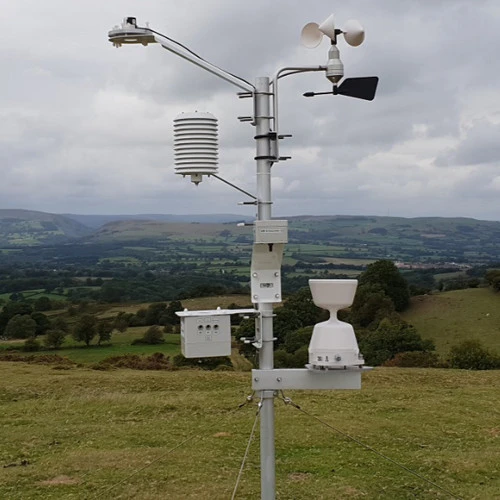Automatic Weather Station : Functionality and Advantages
Automated Weather Stations (AWS) are new tools that collect weather data. They use special sensors and tools for this. These stations are important for weather prediction, climate study, farming, and more.
This article explores how an Automated Weather Station works. It also shows the main benefits they offer to different sectors.
Essential Elements of an Automated Weather Station
Many key parts work together to make an automated weather station. This station gives accurate and reliable weather data. These parts include:
Weather Sensors:
The weather station has key sensors for its job. These sensors measure things like temperature, humidity, and measure wind speed. They also look at wind direction, rainfall, air pressure, and sunlight,solar radiation.
These sensors are high-quality. They detect changes in the weather and send signals as electrical data.
Data Recorder:
The meteorology data logger is the main part of AWS. It collects and arranges data from the sensors. It stores the data for analysis and future use.
Communication System:
To send the collected data, AWS uses various communication networks. These weather station include wired connections, wireless setups, satellite links, and cell networks. This helps with quick data transfer or planned delivery to a main server or users.
Power Supply:
AWS operations need a steady power supply. This is often done with solar panels, batteries, or both. These solutions help keep things running well, even in remote or off-grid areas.
How Does an Automated Weather Station Function?
Once it is set up, an AWS starts to collect weather parameter data in a simple way.
1. **Sensor Monitoring:** Sensors detect changes in the environment. For example, a temperature sensor tracks temperature changes. An anemometer measures how fast the wind blows and which way it is going. A pressure sensor checks for changes in air pressure.
2.**Data Transformation:** The sensors change these measurements into electrical signals. This helps them work well with the station’s processing system.
3. **Data Logging:** The sensors send signals to the data logger. The data logger processes the data. It also arranges the data with timestamps.
4. **Data Storage:** The data logger keeps the processed information in its memory. This ensures enough space for long-term storage.
5. **Data Transmission:** The station sends its data through communication systems. You can send this information to central databases or directly to users. They can then process or display it.
6. **Data Analysis and Visualization:** We look at the data to find patterns, irregularities, or trends. The data logger shows information in simple ways. This includes charts, graphs, and software dashboards. These tools help weather experts, researchers, and workers in the industry make decisions.
Advantages of Automated Weather Stations
Automated Weather Stations have clear advantages over the old methods used by weather fans. Here are some of these advantages:
– **Improved Accuracy:** AWS uses advanced sensors to give accurate and reliable weather data. This accuracy is very important for farming, flying, disaster response, and shipping. Even small mistakes can lead to big problems.
– **Immediate Data Access:** Collecting and sharing real-time weather data helps us make quick decisions. This information helps pilots while they fly. It helps authorities follow storms and supports research on the environment.
**Cost Efficiency:** The setup costs can be high at first, but AWS systems save money in the long run. They need little maintenance and less human help. This lowers costs in the long run.
**Remote Monitoring Capability:** We can set up AWS in hard-to-reach or remote areas. This makes it easier to collect data. AWS sends important data from these places, making them essential for global weather systems.
– **Easy Data Integration:** You can easily add weather information from AWS to other platforms and apps. This helps industries such as energy management, transportation planning, city development, and precision farming. It helps resources work better and leads to better results.
Disadvantages of Automated Weather Stations
Vulnerable to harsh environments
Automated weather stations give us important real-time data for weather, farming, and more. However, they also have some clear drawbacks.
One big problem is that they are not strong in bad weather. Extreme events like hurricanes, tornadoes, and strong lightning can harm the sensors. This can lead to data loss or wrong readings.
A lightning strike can cause electrical surges. These surges can harm sensitive parts in the station.
The maintenance and calibration costs are high
Maintenance and calibration are important tasks. These stations need regular care for accurate measurements. This includes cleaning the sensors. Cleaning helps stop debris or growth from affecting the readings.
Instruments also need to be recalibrated from time to time. In remote areas, getting to the stations for maintenance can be hard. It can take a lot of time and money. It often needs special equipment and trained staff.
Automated weather stations need power sources, such as solar panels or batteries. In cloudy areas, solar panels may not get enough power. Battery-powered stations need to be replaced or recharged often. This can be hard in remote locations places.
The initial cost and ongoing cost are high
The cost of setting up a good automated weather station can be very high. This includes buying sensors, data recorders, and communication tools. Some groups or people with tight budgets may find this too costly.
Even after you install it, there are still some costs. These costs include data storage, transmission, and software management. They add to the financial burden.
Conclusion
In today’s weather monitoring and forecasting, Automated weather stations measure weather conditions are important tools. They use advanced sensors and strong data loggers. These tools help provide accurate weather information in real-time. These stations change industries that depend on weather data.
AWS helps solve problems in weather and climate science. It is known for being reliable, efficient, and flexible.
